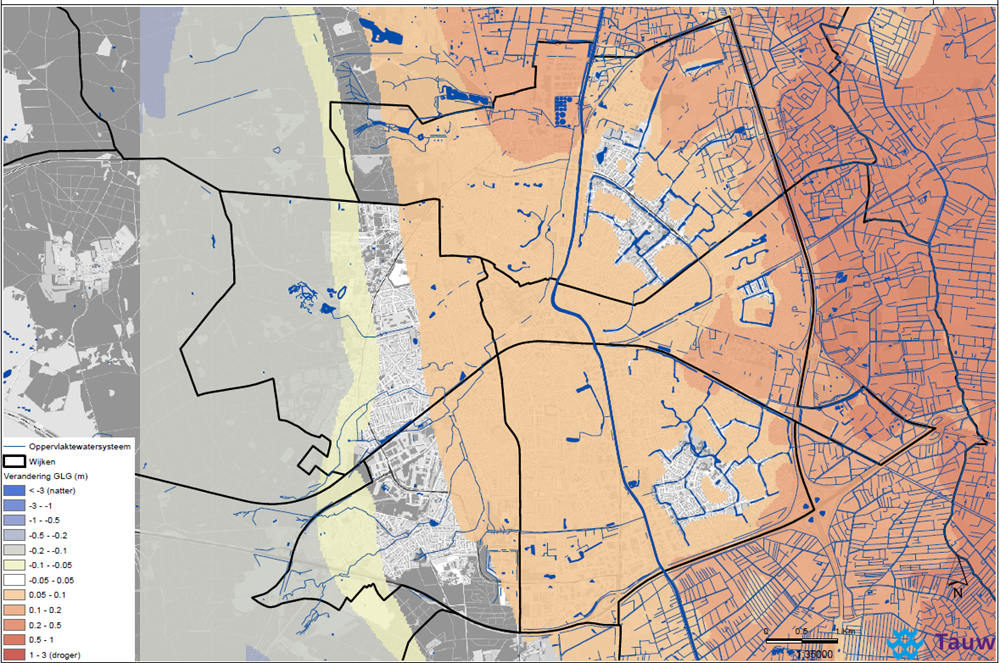Initial analysis of the impact of climate change on groundwater levels in Apeldoorn
The Royal Netherlands Meteorological Institute KNMI expects summer precipitation to decrease by a maximum of 13%. Winter precipitation volumes, on the other hand, will increase. In order to be able to cope with such changes, the municipality of Apeldoorn wants to gain insight into the potential impact of climate change on urban functions. An initial analysis has mapped out the changes and potential impact on soil hydrology and water management. The analysis has shown that urban vegetation in the eastern section of Apeldoorn is particularly prone to drought stress.
Initial analysis of dehydration – set-up
The municipality of Apeldoorn and Tauw Consulting Engineers have conducted the analysis. Examination of KNMI climate data and regional data on bottlenecks in the Apeldoorn water system has generated a rough picture of the potential impact on vegetation, deterioration of surface water quality, the occurrence of dehydration, and waterlogging. Subsequently, the expected climate impact on the groundwater regime were validated on the basis of the Azure regional groundwater model.
Initial analysis of dehydration – results
The Apeldoorn Canal divides the municipality into an eastern and a western section. The western section is characterised by gravity-driven draining spring creeks with low groundwater levels. At many locations, the groundwater level lies more than 2 m below the surface level: the so-called “pendulate water profile”. Because of the low groundwater level, urban vegetation at these locations does not depend on groundwater but rather on precipitation and irrigation. Consequently, the vegetation is not affected by changes in groundwater level caused by climate change.

Image: the map shows the change in average lowest groundwater level for the W+ scenario in 2050
The eastern section of the municipality pursues active water level management. Several neighbourhoods feature a more shallow groundwater level, the so-called “groundwater profile”. Here, urban vegetation does depend on groundwater. In these neighbourhoods, a lower groundwater level due to a shortage of precipitation can result in vegetation drought stress.
One of the findings of the analysis is that the current drought bottlenecks of the urban vegetation are not so much related to the groundwater level but rather to the local layout of the area. A case in point is the urban vegetation in the Centrum neighbourhood. Due to heat stress, limited habitats, and a high degree of paving, the trees need additional irrigation. In terms of surface water quality, the current bottlenecks are mainly related to the seasonal regime; they cannot be univocally linked to periods of drought.
In addition to drought, winters also see water saturation because of the additional precipitation volumes in this season. In the wet areas, this may result in higher groundwater levels which could lead to waterlogging.
Measures to tackle the drought bottlenecks
Adaptations in spatial planning hold great potential for resolving drought bottlenecks in urban vegetation. Such adaptations could involve a layout featuring more growth room for (tree) roots and less paving. Depaving will enable more rainwater to infiltrate into the soil, to be absorbed by the vegetation. Another option is additional irrigation during short periods of extreme drought. The municipality could also consider the use of more drought-resistant types of vegetation when planning urban greenery.
Another outcome of the initial analysis pertains to the monitoring of groundwater levels. Keeping track of climate change induced trends in the groundwater regime requires expansion of the existing monitoring network to cover both dehydration and water saturation. This will enable timely anticipation of the developments.
The results of the initial analysis will serve as the basis for a potential follow-up study into harmful climate effects and cost-effective measures.
Lessons to be learned from the project
- The initial analysis started out as a concise study, but due to the number of substantive questions, it was expanded to include a groundwater model. This is quite efficient: starting small and expanding to a more comprehensive study if need be – from rough to detailed.
- The dehydration stress test adds to the urgency of disconnecting downspouts.
Contact person
Diederik Anema
Gemeente Apeldoorn
d.anema@apeldoorn.nl
